Coronavirus (COVID-19): framework for decision making - supporting evidence
Analytical overview of the key analysis and evidence in support of COVID-19: framework for decision making - further information, summarising data and evidence on the various harms and wider impacts caused by the crisis.
This document is part of a collection
5. Societal Impacts
The restrictions put in place to slow the spread of the virus are in turn causing broader societal harms, including, for example, the negative effects of increased isolation, and the impact on children's wellbeing from closing schools. Societal harms may be more hidden, less tangible, more subjective, and less quantifiable than other harms. We therefore need to draw on a wider range of data and intelligence to understand them.
A longer time horizon is also important, recognising that future impacts (for example the health consequences of loneliness, poverty, domestic abuse, Adverse Childhood Experiences, or lack of sense of purpose/esteem) are no less important than more immediate and measurable health impacts. Moreover, while the direct health consequences of the virus are most prevalent among people who are older, or already sick or in poor health, the social and economic impacts are likely to be greater for younger people, as well as for those living in poorer quality housing, with fewer resources and insecure incomes. Understanding these differential impacts will be an important part of our response.
To help frame this complex multi-faceted area, six dimensions of societal impact have been identified, see Table 1. Alongside these six dimensions of societal harm, impacts on equality and human rights will be central to our assessments.
| Dimension |
Key features |
|---|---|
| 1. Safety and security |
Protection of vulnerable children and adults Crime rates, including cyber, and perceptions of crime Domestic abuse Criminal justice |
| 2. Skills, learning and development |
Early childhood development Student learning and attainment Career progression Participation in education, employment or training |
| 3. Social capital and community cohesion |
Ability to turn to someone for help Volunteering and helping behaviours Ability to influence decisions Digital exclusion |
| 4. Loneliness, anxiety and fear of social interaction |
Levels of loneliness and anxiety Effects of covid-19 on aspects of life Intentions post-lockdown |
| 5. Economic security and welfare |
Benefits claimant rates Fears about household finances; levels of debt Sense of purpose and self-respect |
| 6. Social contract, trust in Government |
Trust in advice and experts Compliance with suppression measures Uptake and satisfaction with services Views that Government is doing a good job |
Safety and security, including protection of vulnerable children
Impacts on crime rates have been both positive and negative. Police Scotland have highlighted that recorded crime has fallen by around a fifth (18%) since measures to support physical distancing came into effect (between 9th March and 26th April), compared to the same time last year[11]. This includes a 15% reduction in crimes of non-sexual violence, a 20% reduction in sexual crimes and a 23% reduction in crimes of dishonesty. Police Scotland previously stated there is some evidence that fraud has increased and that criminals are specifically exploiting the coronavirus public health emergency to commit offences[12]. Police Scotland also stated that they are seeing a slight decrease in domestic abuse incidents but are also acutely aware this may not reflect what is happening behind closed doors and that people do not always report abuse immediately[13].
Children and young people are likely to be impacted most, and for longer, by the unintended consequences and other factors attributable to actions taken to control the pandemic. The effects of the pandemic will not be equally distributed. Some children are more at risk due to individual characteristics, such as disabilities, mental health or neurodevelopmental factors. Some are more at risk due to factors in their immediate environment such as parental relationship conflict, domestic abuse/coercive control, alcohol or substance misuse, and mental health needs of parents. Some are also more at risk because of other parental factors such as age or learning disability. An additional high risk group are those due to make transitions (for example between schools, or from school to college) at this time.
The anticipated impacts on children from physical distancing include impacts on mental health, socialisation and attachment (particularly for younger children). Impacts of 'hidden harm' may affect cognitive, emotional and behavioural functioning and are likely to require significant intervention over the medium and longer term.
There are increased risks of abuse, and of neglect within families, with additional stresses from changes to early learning and childcare, school and business closures, family confinement and isolation, alongside physical and psychological health impacts. There is also an increased risk of harm outside families, including increased sexual and criminal exploitation of children, both online and in the community.
Some examples of the impact on children can already been seen.
There has been a reduction in referrals to children's services during the lockdown period (likely linked to reductions in contact with education and universal health services), with consequent concerns about at risk children not receiving the support and protection they need. For example, in the last week of April 2020, 177 children were subject to an Inter-Agency Referral Discussion between Police, Health & Social Work, where there was information suggesting potential abuse or significant harm to a child. This compares with 222 such discussions at the same time last year. In addition Police Scotland generated 2,606 Child Concern reports for wellbeing concerns during the last week of April. This compares with 3,278 respectively recorded in the same period in 2019. This is because, during the lockdown, it has become extremely difficult to hear the voice of the child, or for others to speak out on their behalf.
Skills, learning and development
Around 1,400 vulnerable children and young people are currently attending local authority education or childcare settings in Scotland (Figure 9). While the number of vulnerable children attending has increased over the weeks, those attending are likely to be a very small percentage of the total.
Over 160,000 children and young people are now accessing their entitlement to Free School Meals (e.g. via vouchers or attending a setting to eat), which is an increase from an estimated 122,000 eligible prior to the outbreak.
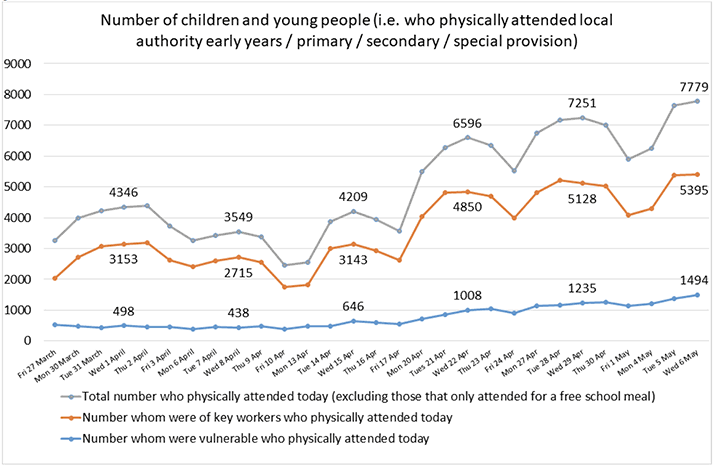
There are clear risks in terms of equity and excellence, with disadvantaged learners at greater risk of negative consequences from school closures and home-based learning. Research by the University of Exeter, and the Centre for Economic Performance at London School of Economics (LSE), estimated that disadvantaged pupils could experience learning losses of between four and six months if Covid-19 school closures last several months[14].
Young people themselves have expressed concerns about the impact of COVID-19. In a survey carried out by a consortium of young people and children's organisations[15] two key findings concerned education and the future:
- Two fifths (42%) of respondents stated that they were extremely or moderately concerned about school, college and university closures. Respondents expressed more concern regarding exams and coursework, with around half (49%) stating that they were moderately or extremely concerned.
- Almost two thirds of respondents (61%) stated that they were moderately or extremely concerned about the impact of coronavirus (COVID-19) on their future.
Young people may experience lasting damage if they enter the labour market during a recession. If they find a job, according to the Institute for Fiscal Studies (IFS), earnings may be up to 6% lower after one year than they were for non-recessionary cohorts and still 2% lower after five years. This effect is particularly evident for school leavers[16].
Social capital and community cohesion
For many groups within society including those shielding, those not digitally connected and those who generally require assistance with daily living, the actions of their local community play a key role in how they experience lockdown. Before lockdown, high levels of trust and neighbourliness were reported across different groups in society although those living in more deprived neighbourhoods, and those who are unemployed or seeking work, reported lower levels of trust[17].
In recent weeks, many people have undertaken informal community activities, with about a quarter doing shopping for a neighbour, friend or family member[18].
The impacts on sense of community are different for different groups of people. For example, in Glasgow over 70% of disabled people are worried about becoming acutely isolated. This relates partly to lack of internet access, and also reflects that many rely on others for support with day to day tasks and looking after themselves[19].
Participation in the lockdown society is largely dependent on digital connectivity and competence. Digital exclusion is a key barrier – an 'inequality enhancer' – for many people. Older people are less likely to have internet access and even if they do they are less likely to use it: a third of households where all adults are over 65, and 60% of households where all adults are over 80, do not have home internet access[20]. Similarly, Glasgow Disability Alliance highlighted that only 37% of disabled people reported having home broadband or IT, and many lack the confidence or skills to use it[21].
Loneliness, anxiety and fear of social interaction
Polling data show that the majority of respondents report feeling anxious, but anxiety levels have decreased during April (Figure 10) and happiness levels are rising (not shown).
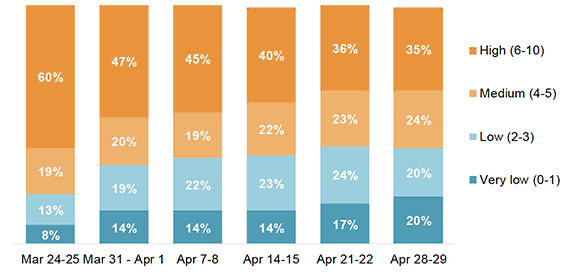
Source: YouGov weekly Scotland survey. Base (n=912-1042)
The public are very supportive of the continuation of lockdown generally and are resigned to staying at home for a longer period. When asked whether the government should start to reduce the restrictions in place, the majority of respondents disagreed although there is an indication of an increase in the proportion of respondents who feel neutral about this (Figure 11). An additional question asked whether it was time to be allowed back out and about: 75% disagreed.
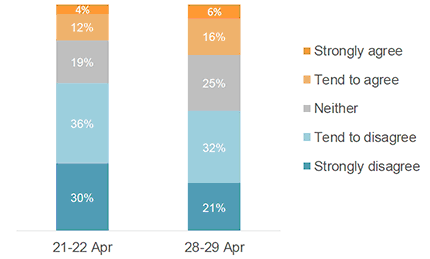
Source: YouGov weekly Scotland survey. Base (n=1011-1042)
Analysis of attitudes across the UK by academics from Kings College London[22] identified three distinct clusters amongst the population in their attitudes to lockdown. The Suffering (48% of the population, and predominantly female), the Accepting (43% of the population and predominantly male) and the Resisting (9% of the population, predominantly male and young). The Suffering display higher levels of anxiety; the Accepting are experiencing less negative impacts. Both groups are strongly supportive of the lockdown approach and do not expect it to end soon. In contrast, only around a quarter of the Resisting group support the lockdown, they expect it to end soon and are less compliant. These differences in views and behaviours highlight the complexity of public attitudes and how they differ across different groups in the population.
Economic security and welfare
Prior to the COVID-19 pandemic, 19% of working-age adults in Scotland were in relative poverty (after housing costs) equivalent to 640,000 adults; 24% of children (230,000 children) were in relative poverty[23].
YouGov survey data shows that 14% of people expect COVID-19 to have a very serious negative financial impact[24]. Families already experiencing poverty will continue to struggle while others will start to experience poverty.
In the most recent wave of polling, 70% of respondents agreed or strongly agreed that coronavirus would have a financial impact on them or their family. More than one in five people are very or extremely concerned about being able to pay bills (Figure 12).
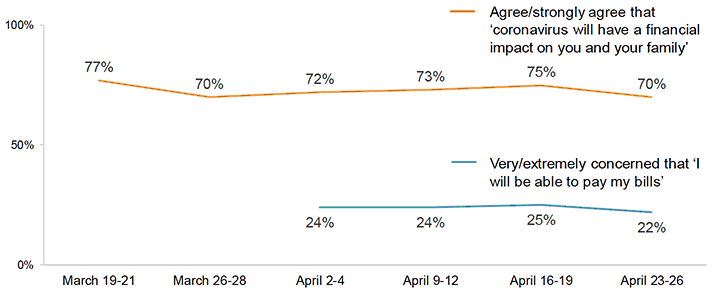
Source: Ipsos MORI, Scotland data. Base(n=568-668)
The number of crisis grant applications made to the Scottish Welfare Fund was more than 50% higher in March 2020 than in March 2019. Figures from the Trussell Trust show an 81% increase in the number of food parcels distributed by food banks in its UK-wide network during the last two weeks of March this year compared to the same period in 2019. Independent food banks across the UK have similarly reported a 59% increase in food parcels distributed from February to March this year, 17 times higher than the same period in 2019[25].
Social contract, trust in Government
Trust in government advice and guidance remains strong. Figures 13 and 14 show that at the end of April, 8 out of 10 people trusted the advice and guidance from the Scottish Government to stay at home, protect the NHS and save lives; and 7 out of 10 trusted the Government to decide when and how it's best to lift the restrictions.
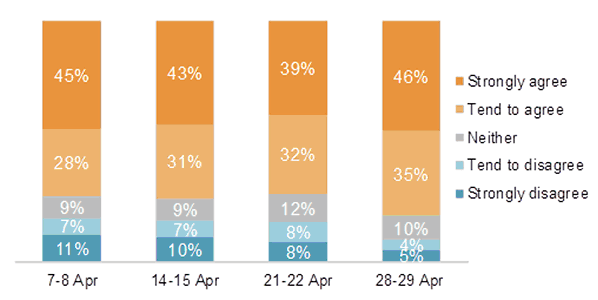
Source: YouGov weekly Scotland survey. Base (n=1011 – 1042)
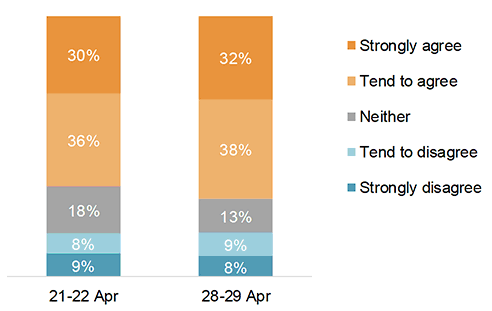
Source: YouGov weekly Scotland survey. Base (n=1011 – 1042)
Contact
Email: CovidExitStrategy@gov.scot
There is a problem
Thanks for your feedback